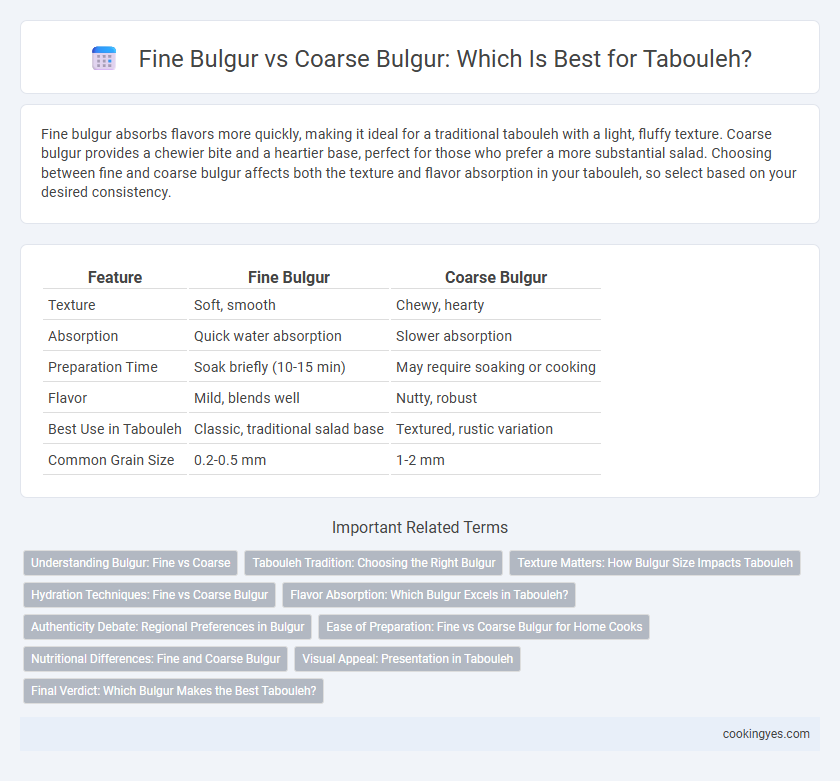Fine bulgur absorbs flavors more quickly, making it ideal for a traditional tabouleh with a light, fluffy texture. Coarse bulgur provides a chewier bite and a heartier base, perfect for those who prefer a more substantial salad. Choosing between fine and coarse bulgur affects both the texture and flavor absorption in your tabouleh, so select based on your desired consistency.
Table of Comparison
| Feature | Fine Bulgur | Coarse Bulgur |
|---|---|---|
| Texture | Soft, smooth | Chewy, hearty |
| Absorption | Quick water absorption | Slower absorption |
| Preparation Time | Soak briefly (10-15 min) | May require soaking or cooking |
| Flavor | Mild, blends well | Nutty, robust |
| Best Use in Tabouleh | Classic, traditional salad base | Textured, rustic variation |
| Common Grain Size | 0.2-0.5 mm | 1-2 mm |
Understanding Bulgur: Fine vs Coarse
Fine bulgur, with its small, soft grains, absorbs flavors quickly and creates a tender texture ideal for traditional tabouleh, enhancing the freshness of parsley and lemon. Coarse bulgur retains a chewier bite and offers a heartier texture, making it suitable for those who prefer a more substantial base in their tabouleh. Choosing between fine and coarse bulgur impacts the salad's overall mouthfeel and how well it blends with tomatoes, mint, and olive oil.
Tabouleh Tradition: Choosing the Right Bulgur
Tabouleh tradition emphasizes the use of fine bulgur as the ideal base due to its light, fluffy texture, which absorbs lemon juice and olive oil more effectively. Coarse bulgur, while popular in other Middle Eastern dishes, can overwhelm the delicate balance of fresh parsley, mint, and tomatoes in tabouleh. Selecting fine bulgur preserves the salad's signature refreshing and vibrant consistency, maintaining authenticity and optimal flavor.
Texture Matters: How Bulgur Size Impacts Tabouleh
Fine bulgur creates a softer, more cohesive texture in tabouleh, allowing the parsley, mint, and tomatoes to blend seamlessly for a delicate mouthfeel. Coarse bulgur offers a chewier bite, adding structural contrast and a heartier presence that stands up well to hearty herbs and dressings. Selecting bulgur size depends on desired textural balance, influencing the salad's overall freshness and how flavors are perceived.
Hydration Techniques: Fine vs Coarse Bulgur
Fine bulgur absorbs water more quickly and evenly, making it ideal for traditional tabouleh that requires a tender, cohesive texture. Coarse bulgur demands longer soaking or brief simmering to fully hydrate, resulting in a chewier bite that can alter tabouleh's classic freshness. Mastering hydration techniques for fine and coarse bulgur ensures optimal moisture retention and texture balance in tabouleh preparation.
Flavor Absorption: Which Bulgur Excels in Tabouleh?
Fine bulgur excels in flavor absorption for tabouleh due to its smaller particle size, allowing it to soak up the lemon juice, olive oil, and herb flavors more thoroughly, resulting in a vibrant and cohesive taste. Coarse bulgur, while providing a chewier texture, absorbs liquids less efficiently, which can dilute the overall flavor intensity of the salad. For a traditional, well-infused tabouleh, fine bulgur remains the preferred choice to maximize the dish's characteristic bright and fresh flavor profile.
Authenticity Debate: Regional Preferences in Bulgur
Authentic tabouleh traditionally uses fine bulgur, especially favored in Lebanese and Syrian cuisine for its delicate texture that absorbs lemon juice and olive oil perfectly. Coarse bulgur, preferred in some regional variations like Palestinian or Jordanian recipes, offers a heartier bite and a more rustic flavor profile. The debate over bulgur texture highlights cultural nuances where fine bulgur symbolizes the classic freshness of Levantine tabouleh, while coarse bulgur embraces a robust, grain-forward interpretation.
Ease of Preparation: Fine vs Coarse Bulgur for Home Cooks
Fine bulgur is preferred for tabouleh due to its quick absorption of water, allowing home cooks to prepare the base without lengthy soaking or cooking times. Coarse bulgur requires longer soaking or boiling, making it less convenient for fast tabouleh preparation. The finer texture of fine bulgur blends seamlessly with chopped herbs and vegetables, enhancing ease of mixing and digestion in this traditional salad.
Nutritional Differences: Fine and Coarse Bulgur
Fine bulgur used in tabouleh offers quicker digestion and higher glycemic index, providing rapid energy release, whereas coarse bulgur contains more fiber and protein, promoting better satiety and digestive health. Nutritionally, coarse bulgur retains more bran and germ, resulting in increased vitamins, minerals, and antioxidants compared to the more processed fine bulgur. Choosing between fine and coarse bulgur impacts fiber intake, digestion speed, and overall nutrient density in tabouleh recipes.
Visual Appeal: Presentation in Tabouleh
Fine bulgur creates a smoother, more uniform texture that absorbs lemon juice and olive oil evenly, enhancing tabouleh's vibrant green parsley and red tomato colors for an appealing, cohesive presentation. Coarse bulgur offers a chewier, chunkier texture with visible grains that add rustic contrast but can overshadow the fresh vegetable colors, making the dish look less refined. Selecting fine bulgur highlights tabouleh's fresh ingredients and contributes to a visually polished and inviting plate.
Final Verdict: Which Bulgur Makes the Best Tabouleh?
Fine bulgur is traditionally preferred for tabouleh due to its ability to absorb flavors quickly and provide a tender, cohesive texture that blends seamlessly with fresh parsley, mint, and lemon. Coarse bulgur offers a chewier bite and retains more texture, appealing to those who favor a heartier salad, but it can overpower the delicate balance of ingredients. For an authentic and well-balanced tabouleh, fine bulgur remains the ideal choice, delivering the perfect harmony of softness and flavor infusion.
Fine Bulgur vs Coarse Bulgur for Tabouleh base Infographic

 cookingyes.com
cookingyes.com